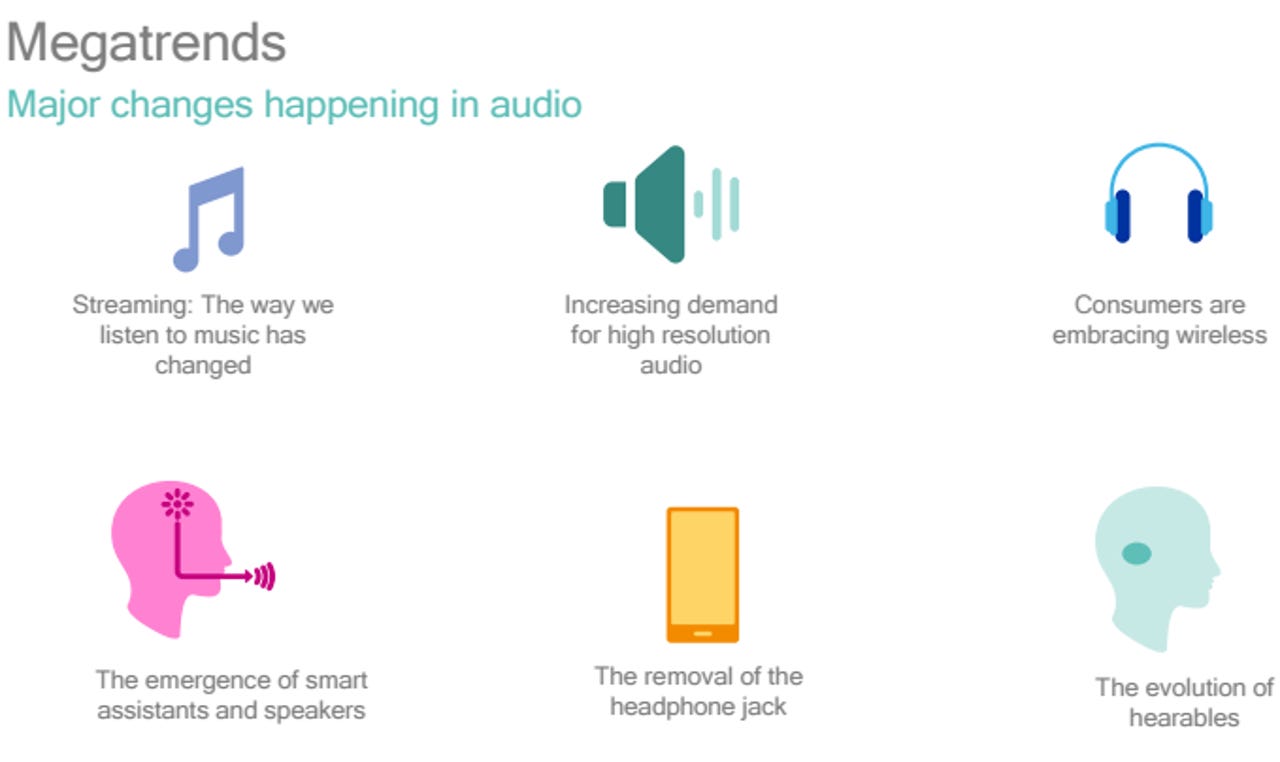As trends like voice UIs grow, Qualcomm introduces new audio technologies


For years, television manufacturers focused on improving picture quality while ignoring or even degrading sound quality. Now, however, manufacturers are effectively aiming to produce the equivalent of the HD experience for audio.
Meanwhile, as their sound systems improve, consumers now expect to use their speakers for more than just listening to music or movies -- they want to talk back to them, asking Amazon's Alexa or Google Home for some kind of assistance. And as the worlds of IoT and wearables grow, so will consumer demand for more sophisticated hearing devices with functionality like real-time translation.
These are some of the trends Qualcomm plans to go after with the series of new audio technologies the company is rolling out Tuesday. Qualcomm's new products include next-generation amplifier chipsets for headphones and speakers, as well as new audio system-on-chip (SoCs) platforms. Additionally, Qualcomm is introducing a smart audio platform with multi-room technology, which will help manufacturers accelerate the development of smart speakers.
The new products should advance Qualcomm's position in the traditional audio market and extend it into new audio markets.
"If we look at just the audio market, all the existing audio brands out there -- there's hundreds of familiar, Tier-1 brands that people know, then there's multiple small brands -- they all want to offer an Alexa-type of experience with their product," Anthony Murray, SVP and GM for voice and music at Qualcomm, said to ZDNet. "But if you look more broadly across the market for that voice UI, whether manufacturers are building a fridge or even coffee makers, they're also saying they'd like to have Google Home or Alexa support.
"It's early days, but we're going to see some weird and wonderful products coming out with these digital assistant capabilities," he continued. "Our goal is to make it as easy and robust as possible, so these manufacturers can focus on bringing forward new use cases... instead of spending years making the Alexa aspect work reliably on their particular product."
To that end, Qualcomm is introducing the CSRA68100, a high performance single chip Bluetooth audio flash-programmable platform for premium wireless speakers and headphones. It offers four times the digital signal processing power of its predecessor, along with a 32-bit dedicated developer application processor. That should enable manufacturers "to deliver that consumer experience that historically wasn't required because the use cases weren't there," Murray said. For instance, it will enable voice recognition on multi-functional speakers.
While the CSRA68100 is designed for high-end devices, the new QCC3XXX family of flash-programmable audio SoC platforms is designed for Bluetooth headsets and speakers at different, more competitive price points. Qualcomm is also introducing single-chip USB audio SoC platforms, designed specifically for USB-C connected audio devices. As smartphone manufacturers start removing the 3.5mm headphone jack, the USB-C connectors offer an option for people who want to keep using wired headsets and speakers.
Meanwhile, Qualcomm's next generation audio amplifier technology, the CSRA6620 SoC, offers high-quality amplifier performance while integrating it into a single chip. This should give a much broader customer base access premium-end amplifiers, Murray said, providing hihg-resolution sound for devices like wireless speakers, soundbars, networked audio and headphone amplifiers. Better sound quality on devices like headphones, combined with multi-functionality, could grow the market for important use cases like hearing assistance, Murray pointed out.
For manufacturers building networked speakers with voice capability, Qualcomm is rolling out the Smart Audio Platform. The platform offers two SoC options with a range of software configurations giving manufacturers flexibility to build for different product tiers and categories. It's designed for advanced, multi-mic far-field voice capability, and the platform's voice software also incorporates echo-cancellation, noise suppression and "barge-in" capability. All of this adds up to a voice UI that works in loud or noisy environments, even when users are far from the smart speaker.
Typically, building a soundbar with high-quality sound, voice recognition and multi-room functionality would take multiple chips from multiple vendors, along with third-party software. The platform, Murray said, should streamline the process. It offers "enough flexibility that our customers can take it as a starting point, add their own differentiation, and bring it to market in a much quicker time frame, at a much lower price point," Murray said.